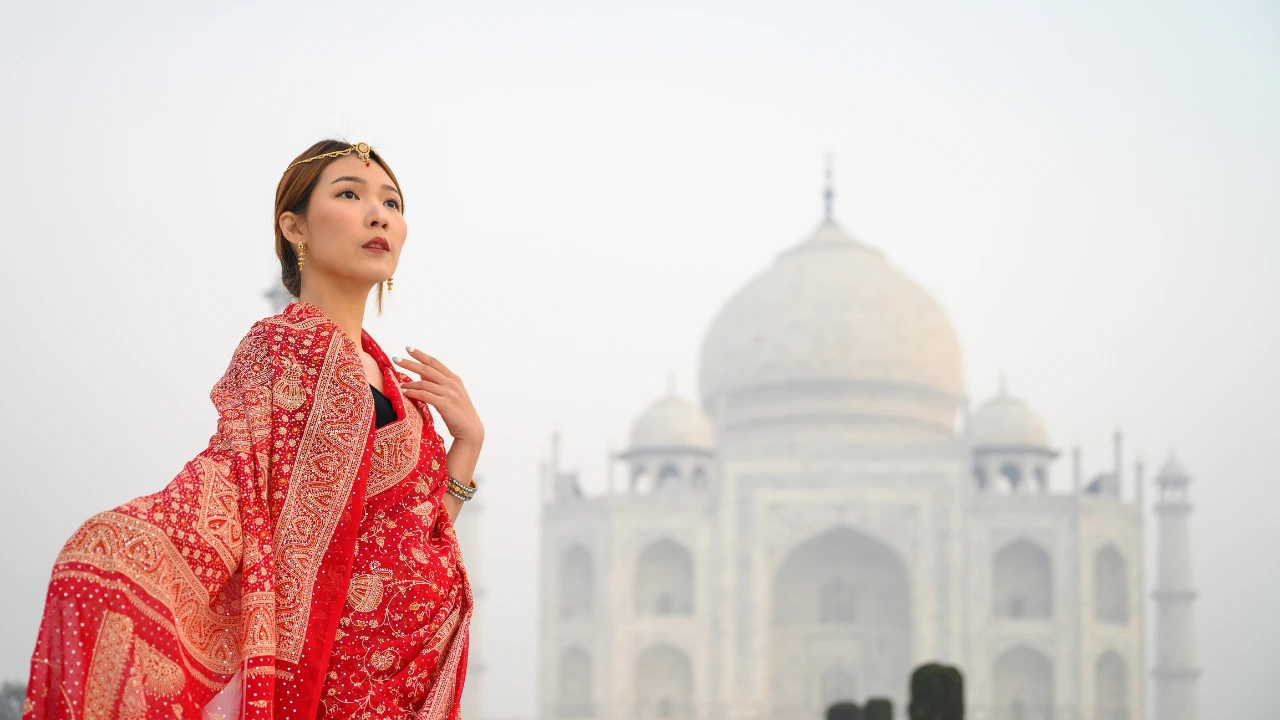Saree, the quintessential Indian garment, showcases an incredible range of draping styles that vary from region to region. Each state brings its unique cultural heritage to the art of draping, resulting in an array of captivating styles that reflect tradition, innovation, and individuality. Let’s embark on a journey through Indian states and 5 distinct saree draping styles.

Nivi Style
The Nivi style of saree draping is one of the most common and popular draping techniques in India. It is believed to have originated from Andhra Pradesh and is characterized by its simplicity and elegance. The Nivi style is often associated with the modern saree drape that is widely worn today.
Here’s how the Nivi saree is draped:
- Begin by tucking the plain end of the saree (the end without the pallu) into the petticoat or underskirt at the center, just above the navel.
- Make about 5 to 7 pleats, each around 5-6 inches wide, and even in size. These pleats should face towards the left.
- Tuck the pleats into the waistband of the petticoat, ensuring they are neat and aligned.
- The remaining loose end of the saree called the pallu, is taken over the left shoulder from back to front.
- Allow the pallu to hang freely over the left shoulder. Adjust the length as per your preference, with the pallu ending around mid-thigh or knee level.
- Pleat the pallu neatly, either in a straight line or in a fan-like arrangement, depending on your personal style.
- Secure the pleated pallu to the left shoulder with a pin or tuck it into the waistband to keep it in place.
This style of draping allows for easy movement and comfort while exuding a sense of sophistication. The Nivi style is versatile and can be worn with various types of sarees, ranging from casual to formal, depending on the occasion. It is known for its flattering silhouette and is often chosen by women for its timeless appeal.
The Nivi style of saree draping has become a staple choice for women across India and even internationally, as it combines tradition with modernity, making it suitable for a wide range of events and gatherings.
- State of Origin: Andhra Pradesh & Telangana
- Draping Style: The Nivi drape is known for its simplicity and elegance. The saree is pleated at the waist and the pallu is thrown over the shoulder.
- Popular Sarees: Gadwal, Pochampally, Venkatagiri sarees
Bengali Style
The Bengali saree drape, also known as the “Bengali style,” is a traditional draping technique specific to the region of West Bengal in India.
The Bengali saree drape involves intricate and unique pleating techniques, resulting in a graceful and elegant look. Unlike many other draping styles, the Bengali saree drape highlights the beauty of the saree’s pallu (the decorative end of the saree) by draping it twice around the body.
Here’s how the Bengali saree is draped:
- Start by tucking one end of the saree into the petticoat or underskirt, ensuring that the saree is wrapped snugly around the waist.
- Make a few pleats with the remaining length of the saree and tuck them into the front of the petticoat, slightly to the left.
- Take the remaining fabric and bring it around the waist, from the front to the back.
- Drape the saree fabric over the left shoulder, allowing it to fall down the back.
- Bring the pallu forward from behind the back and drape it over the left shoulder once more. This creates the distinctive double-layered pallu effect.
- Adjust the pleats, pallu, and overall drape to achieve the desired look.
The Bengali saree drape is not just a fashion statement; it carries deep cultural significance. It’s a reflection of the rich heritage and traditions of Bengal, representing the elegance and strength of Bengali women. This style of draping is often associated with festive occasions, cultural events, and ceremonies.
State of Origin: West Bengal
Draping Style: The Bengali style involves pleating the saree in the front and draping the pallu around the waist from back to front.
Popular Sarees: Baluchari, Taant, Kantha sarees
Gujarati Style
The Gujarati saree drape, also known as the “Seedha Pallu” style, is a traditional way of draping the saree that originates from the western Indian state of Gujarat. This draping style is characterized by the unique placement of the pallu, or the loose end of the saree.
Here’s how the Gujarati saree drape is done:
- Pleating: Start by tucking the plain end of the saree (the non-pallu end) into the waistband of your petticoat, making sure it’s secured snugly.
- Wrap Around: Take the other end of the saree (the pallu) and wrap it around your body once, from right to left, and bring it to the front over your left shoulder.
- Adjust the Pallu: Now, instead of allowing the pallu to fall over the shoulder, you bring it back over your right shoulder diagonally, so it crosses your chest in an “X” shape.
- Pleat the Pallu: Gather the pallu into pleats, making sure it’s neat and even. Pin the pleats together to keep them in place.
- Pin the Pleats: Use a decorative brooch or safety pin to secure the pleats in place at your right shoulder.
- Tuck the Pallu: Take the pleated pallu and tuck it into the front of your waistband, slightly to the left side.
The Gujarati saree drape is known for its vibrant and colorful pallus, often embellished with embroidery, mirror work, or other decorative elements. This style allows the pallu to flow gracefully down the front, showcasing its intricate designs. It’s a popular choice for festive occasions and cultural events in Gujarat and has also gained popularity across India for its unique and eye-catching look.
State of Origin: Gujarat
Draping Style: The saree is draped in a way that the pallu comes from the back to the front, and a portion of it is pleated across the shoulder.
Popular Sarees: Bandhani, Patola, Gharchola sarees
Maharashtrian Style
The Maharashtrian saree drape, also known as “Kasta Sari” or “Maharashtrian Nauvari Sari,” is a distinctive style of draping the saree that originates from the state of Maharashtra in India. Unlike the conventional saree draping styles, the Nauvari saree is draped in a unique way that gives it a trouser-like appearance.
Here’s how the Maharashtrian Nauvari saree is draped:
- Pleating: Start by tucking the plain end of the saree (non-pallu end) at the center of the waist. Make a few pleats and tuck them into the front waist, allowing the remaining length to hang freely.
- Pallu: Take the remaining length of the saree, the pallu, and drape it over the left shoulder, allowing it to hang down the back.
- Leg Division: The distinct feature of the Nauvari saree is the division of the legs. The saree is tucked between the legs and secured at the back, creating a trouser-like appearance. This division enables ease of movement and is particularly practical for Maharashtrian women who often engage in various activities.
- Final Touches: Once the saree is tucked between the legs and secured at the back, arrange the pallu gracefully over the left shoulder, allowing it to fall gracefully down the front.
The Maharashtrian Nauvari saree drape is not only a traditional attire but also a symbol of strength, practicality, and cultural identity for Maharashtrian women. It is often worn during festivals, cultural events, and weddings, showcasing the rich heritage of Maharashtra and the unique way in which its women express their elegance and individuality.
- State of Origin: Maharashtra
- Draping Style: The saree is draped in a unique dhoti style, and the pallu is worn like a veil over the head.
- Popular Sarees: Paithani, Narayanpet, Yeola Paithani sarees
Parsi Gara Style
The Parsi saree drape, also known as the “Parsi Gara” style, is a distinctive way of draping a saree that is associated with the Parsi community in India. The drape is known for its elegance and unique way of showcasing the intricate embroidery of Parsi Gara sarees.
Parsi Saree Drape Steps
- Start with the Nivi Style: Begin by tucking the plain end of the saree (non-pallu end) into the petticoat at your left hip. Make sure the saree is positioned slightly to the right to leave enough fabric for the pallu.
- Pleat the Pallu: Take the pallu (decorative end) of the saree and make thin, even pleats. The number of pleats can vary depending on the length of the pallu and personal preference. Once pleated, drape the pallu across your chest diagonally, from the right shoulder to the left hip.
- Secure the Pallu: Pin the pleated pallu to your left shoulder to keep it in place. Make sure the pallu falls gracefully and covers your blouse and midriff.
- Drape the Pallu at the Back: Take the loose end of the pallu that’s hanging from your left shoulder and bring it around your back, over your right shoulder. The pallu should be draped over your right shoulder and hang down your back.
- Adjust the Pallu: Adjust the pleats of the pallu hanging at your back to create a neat and graceful fall. The end of the pallu should ideally reach the height of your knees
The Parsi saree drape is known for its asymmetrical and layered look, which beautifully showcases the intricate patterns of Parsi Gara sarees. It’s a unique and graceful way to wear a saree, reflecting the cultural identity and artistic sensibilities of the Parsi community.
- State of Origin: Maharashtra, Gujarat
- Draping Style: The saree is draped in a Parsi Gara style, with the pallu pinned at one shoulder and the pleats tucked at the back.
- Popular Sarees: Parsi Gara sarees
Final Thoughts
The diversity of saree draping styles across India is a testament to the country’s rich culture and heritage. From the graceful Nivi style of Andhra Pradesh to the intricate Parsi Gara style of Maharashtra, each state’s draping technique carries its own charm and significance. These styles not only add beauty to the saree but also embody the cultural stories of their respective regions, making the saree a canvas of tradition and artistry.
